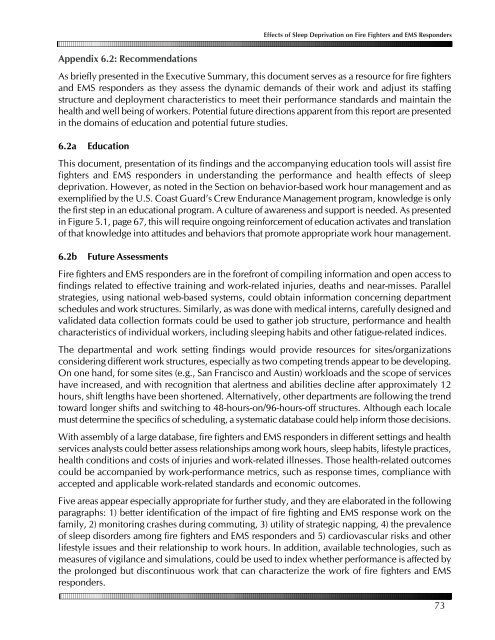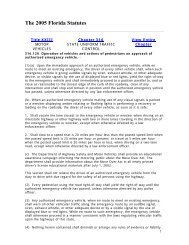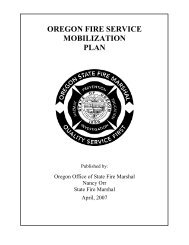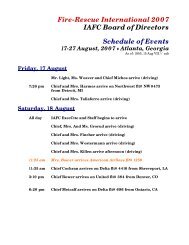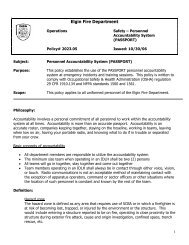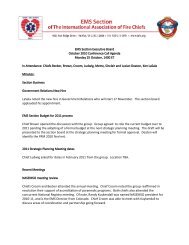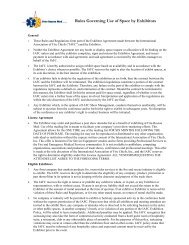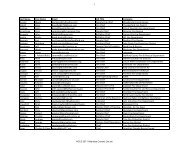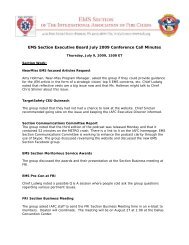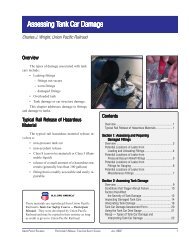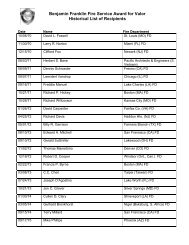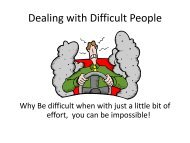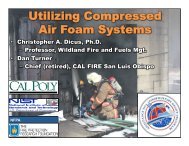Effects of Sleep Deprivation on Fire Fighters and EMS ... - NAEMT
Effects of Sleep Deprivation on Fire Fighters and EMS ... - NAEMT
Effects of Sleep Deprivation on Fire Fighters and EMS ... - NAEMT
Create successful ePaper yourself
Turn your PDF publications into a flip-book with our unique Google optimized e-Paper software.
<str<strong>on</strong>g>Effects</str<strong>on</strong>g> <str<strong>on</strong>g>of</str<strong>on</strong>g> <str<strong>on</strong>g>Sleep</str<strong>on</strong>g> <str<strong>on</strong>g>Deprivati<strong>on</strong></str<strong>on</strong>g> <strong>on</strong> <strong>Fire</strong> <strong>Fighters</strong> <strong>and</strong> <strong>EMS</strong> Resp<strong>on</strong>ders<br />
Appendix 6.2: Recommendati<strong>on</strong>s<br />
As briefly presented in the Executive Summary, this document serves as a resource for fire fighters<br />
<strong>and</strong> <strong>EMS</strong> resp<strong>on</strong>ders as they assess the dynamic dem<strong>and</strong>s <str<strong>on</strong>g>of</str<strong>on</strong>g> their work <strong>and</strong> adjust its staffing<br />
structure <strong>and</strong> deployment characteristics to meet their performance st<strong>and</strong>ards <strong>and</strong> maintain the<br />
health <strong>and</strong> well being <str<strong>on</strong>g>of</str<strong>on</strong>g> workers. Potential future directi<strong>on</strong>s apparent from this report are presented<br />
in the domains <str<strong>on</strong>g>of</str<strong>on</strong>g> educati<strong>on</strong> <strong>and</strong> potential future studies.<br />
6.2a Educati<strong>on</strong><br />
This document, presentati<strong>on</strong> <str<strong>on</strong>g>of</str<strong>on</strong>g> its findings <strong>and</strong> the accompanying educati<strong>on</strong> tools will assist fire<br />
fighters <strong>and</strong> <strong>EMS</strong> resp<strong>on</strong>ders in underst<strong>and</strong>ing the performance <strong>and</strong> health effects <str<strong>on</strong>g>of</str<strong>on</strong>g> sleep<br />
deprivati<strong>on</strong>. However, as noted in the Secti<strong>on</strong> <strong>on</strong> behavior-based work hour management <strong>and</strong> as<br />
exemplified by the U.S. Coast Guard’s Crew Endurance Management program, knowledge is <strong>on</strong>ly<br />
the first step in an educati<strong>on</strong>al program. A culture <str<strong>on</strong>g>of</str<strong>on</strong>g> awareness <strong>and</strong> support is needed. As presented<br />
in Figure 5.1, page 67, this will require <strong>on</strong>going reinforcement <str<strong>on</strong>g>of</str<strong>on</strong>g> educati<strong>on</strong> activates <strong>and</strong> translati<strong>on</strong><br />
<str<strong>on</strong>g>of</str<strong>on</strong>g> that knowledge into attitudes <strong>and</strong> behaviors that promote appropriate work hour management.<br />
6.2b Future Assessments<br />
<strong>Fire</strong> fighters <strong>and</strong> <strong>EMS</strong> resp<strong>on</strong>ders are in the forefr<strong>on</strong>t <str<strong>on</strong>g>of</str<strong>on</strong>g> compiling informati<strong>on</strong> <strong>and</strong> open access to<br />
findings related to effective training <strong>and</strong> work-related injuries, deaths <strong>and</strong> near-misses. Parallel<br />
strategies, using nati<strong>on</strong>al web-based systems, could obtain informati<strong>on</strong> c<strong>on</strong>cerning department<br />
schedules <strong>and</strong> work structures. Similarly, as was d<strong>on</strong>e with medical interns, carefully designed <strong>and</strong><br />
validated data collecti<strong>on</strong> formats could be used to gather job structure, performance <strong>and</strong> health<br />
characteristics <str<strong>on</strong>g>of</str<strong>on</strong>g> individual workers, including sleeping habits <strong>and</strong> other fatigue-related indices.<br />
The departmental <strong>and</strong> work setting findings would provide resources for sites/organizati<strong>on</strong>s<br />
c<strong>on</strong>sidering different work structures, especially as two competing trends appear to be developing.<br />
On <strong>on</strong>e h<strong>and</strong>, for some sites (e.g., San Francisco <strong>and</strong> Austin) workloads <strong>and</strong> the scope <str<strong>on</strong>g>of</str<strong>on</strong>g> services<br />
have increased, <strong>and</strong> with recogniti<strong>on</strong> that alertness <strong>and</strong> abilities decline after approximately 12<br />
hours, shift lengths have been shortened. Alternatively, other departments are following the trend<br />
toward l<strong>on</strong>ger shifts <strong>and</strong> switching to 48-hours-<strong>on</strong>/96-hours-<str<strong>on</strong>g>of</str<strong>on</strong>g>f structures. Although each locale<br />
must determine the specifics <str<strong>on</strong>g>of</str<strong>on</strong>g> scheduling, a systematic database could help inform those decisi<strong>on</strong>s.<br />
With assembly <str<strong>on</strong>g>of</str<strong>on</strong>g> a large database, fire fighters <strong>and</strong> <strong>EMS</strong> resp<strong>on</strong>ders in different settings <strong>and</strong> health<br />
services analysts could better assess relati<strong>on</strong>ships am<strong>on</strong>g work hours, sleep habits, lifestyle practices,<br />
health c<strong>on</strong>diti<strong>on</strong>s <strong>and</strong> costs <str<strong>on</strong>g>of</str<strong>on</strong>g> injuries <strong>and</strong> work-related illnesses. Those health-related outcomes<br />
could be accompanied by work-performance metrics, such as resp<strong>on</strong>se times, compliance with<br />
accepted <strong>and</strong> applicable work-related st<strong>and</strong>ards <strong>and</strong> ec<strong>on</strong>omic outcomes.<br />
Five areas appear especially appropriate for further study, <strong>and</strong> they are elaborated in the following<br />
paragraphs: 1) better identificati<strong>on</strong> <str<strong>on</strong>g>of</str<strong>on</strong>g> the impact <str<strong>on</strong>g>of</str<strong>on</strong>g> fire fighting <strong>and</strong> <strong>EMS</strong> resp<strong>on</strong>se work <strong>on</strong> the<br />
family, 2) m<strong>on</strong>itoring crashes during commuting, 3) utility <str<strong>on</strong>g>of</str<strong>on</strong>g> strategic napping, 4) the prevalence<br />
<str<strong>on</strong>g>of</str<strong>on</strong>g> sleep disorders am<strong>on</strong>g fire fighters <strong>and</strong> <strong>EMS</strong> resp<strong>on</strong>ders <strong>and</strong> 5) cardiovascular risks <strong>and</strong> other<br />
lifestyle issues <strong>and</strong> their relati<strong>on</strong>ship to work hours. In additi<strong>on</strong>, available technologies, such as<br />
measures <str<strong>on</strong>g>of</str<strong>on</strong>g> vigilance <strong>and</strong> simulati<strong>on</strong>s, could be used to index whether performance is affected by<br />
the prol<strong>on</strong>ged but disc<strong>on</strong>tinuous work that can characterize the work <str<strong>on</strong>g>of</str<strong>on</strong>g> fire fighters <strong>and</strong> <strong>EMS</strong><br />
resp<strong>on</strong>ders.<br />
73


